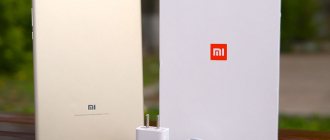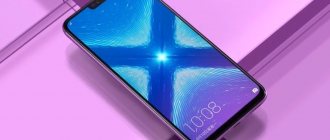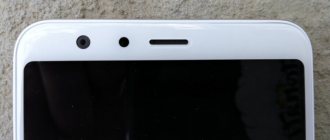Design
While the front panels look very similar, the reverse sides are completely different. So, Huawei Enjoy 7S and Xiaomi Redmi 5 Plus are frameless smartphones, which means that the display occupies almost the entire front panel. They don't have a Home button and both smartphones use on-screen buttons. At the top, you can see the front camera and other sensors.
The fingerprint scanner is located on the back of both smartphones. Also here you can see the company logo.
However, the Xiaomi Redmi 5 Plus comes with a single camera above the fingerprint sensor. I want to point out that Redmi 5 is very similar to Redmi Note 4.
As for Huawei Enjoy 7S, it has a dual main camera on the left corner.
Moreover, smartphones come in different sizes because they have different display sizes. So, Huawei Enjoy 7S is thinner and more compact, while Xiaomi Redmi 5 Plus is larger because the display is larger.
Design is a very personal thing, so it's hard to pick a winner. But I prefer Huawei Enjoy 7S because it comes with a more compact size.
Display
As I said, smartphones have different displays. Huawei Enjoy 7S is equipped with a 5.65-inch screen and Full HD+ resolution. The aspect ratio is 18:9 and the pixel density is 428 pixels. The display is made using IPS LCD technology.
As for the Xiaomi smartphone, it comes with a 6-inch display and other specifications are almost the same as the Huawei device, such as Full HD+ resolution, 18:9 aspect ratio, IPS LCD technology and a lower pixel density of 402 pixels.
So both smartphones have almost identical displays and I can't pick a winner. If you want a large display, you should buy the Xiaomi Redmi 5 Plus. If you prefer a compact size, then a Huawei smartphone will be the best option for you. I'll give the phones one point each. It will be fair.
Smartphone body and its features
The dimensions of the smartphone are 7.16 cm³ smaller than the average (105.15 cm³) for gadgets from 2017-2020 with similar screen sizes. At the same time, the width of the case is 76.4 mm, making the device more comfortable to hold in your hands.
In terms of thickness, Enjoy 7 Plus is the standard among competitors with an indicator of 8.35 mm (the average of competitors is ≈ 9.18 mm).
The assembled smartphone weighs 165 g, which makes it light among its analogues (13.01 g lighter than the average weight ≈ 178.01 g).
The body materials are:
- Metal
These materials are inherent in premium phones, which affects the cost of the device.
Performance
When it comes to memory, both smartphones are identical. Both of them have 3 or 4 GB of RAM and 32 or 64 GB of internal memory. They also support microSD memory cards.
However, Huawei Enjoy 7S is powered by Kirin 659 octa chipset clocked at 2.3GHz while Xiaomi Redmi 5 Plus has a Snapdragon 625 processor clocked at 2GHz. So, in practice, the Snapdragon 625 may be more energy efficient, while the Kirin 659 may be more powerful.
The Huawei smartphone scores about 65,000 points in AnTuTu, while the Xiaomi device scores about 60 thousand. The difference is not that big, and in real life you are unlikely to notice it.
So the smartphones have almost the same performance and again I will give them one point each.
Huawei Enjoy 7 Plus comparison with Huawei Enjoy 6S
| Huawei Enjoy 7 | Huawei Enjoy 6S |
|
|
The external similarity of these two models is striking. If it were not for the difference in diagonal size, it would be difficult to distinguish Huawei Enjoy 7 Plus and Huawei Enjoy 6S at first glance. But still, placing these two gadgets side by side, the first one is given an advantage of 0.5 inches. The smartphones from the Enjoy line presented in the table are equipped with the same processor - the eight-core Qualcomm Snapdragon 435 MSM8940. Based on this, we conclude that the Antutu performance test results for these smartphones will also be the same. The main difference between these two smartphones is the battery capacity. The new Huawei Enjoy 7 Plus has 4000 mAh, unlike its predecessor. The battery capacity of the latter is only 3020 mAh. Huawei Enjoy 6S is saved by the presence of the fast charging function. Speaking about the memory of both smartphones, it is worth noting that the volume of both RAM and built-in memory is the same. Both mobile devices are equipped with a main camera with a 13 MP matrix resolution. But if we talk about the front camera, there are slight differences in the specifications of Huawei Enjoy 7 Plus and Huawei Enjoy 6S. The front camera of the first has a resolution of 8 MP, while its competitor has 5 MP. Well, in conclusion, it is necessary to mention the operating systems on which the gadgets operate. In the case of Huawei Enjoy 7 Plus is Android 7.0, its predecessor deals with an older version of Android. We can talk endlessly about Huawei, whose smartphones almost always have excellent value for money. But it’s better to try once and make sure, or refute the laudatory odes towards the Chinese manufacturer.
Software
Huawei Enjoy 7S runs on Android 8.0 Oreo, which means you will have the latest version of Android immediately after purchasing the smartphone. It also has EMUI user interface.
Xiaomi Redmi 5 Plus runs on Android 7.1 Nougat, but the manufacturer promises an update in the near future. Moreover, Xiaomi smartphones have MIUI user interface.
I think Huawei Enjoy 7S is a winner because it offers the latest Android system.
Camera
When it comes to cameras, I can say right now that the Huawei Enjoy 7S is a winner. It has a dual rear camera with 13 and 2 megapixel sensors and an 8 megapixel front camera.
Xiaomi Redmi 5 Plus has one 12-megapixel main camera and a 5-megapixel front camera. As you can see, Huawei Enjoy 7S looks better.
I'll give the win to the Huawei smartphone, but we need to see real photos to make a final conclusion.
Specifications Huawei P Smart
The device is equipped with a widescreen screen with 18:9 sides and a diagonal of 5.65″. The matrix is of the IPS type, its resolution reaches 2160x1080 pixels. And, as is the case with the design, it is impossible to single out any specific features; many competitors have such screens.
The smartphone chipset is Kirin 859, which is a rival to the Snapdragon 625. It is equipped with eight A53 cores with a frequency of up to 2.36 GHz, a Mali T830 MP2 graphics processor and is manufactured using a 16 nm process technology. This chip is still relevant in smartphones under $300. Although this is not the best option, its performance is still sufficient for all tasks.
The RAM on board Huawei P Smart can be 3 or 4 GB, and the storage capacity can be 32 or 64 GB, respectively. There is a slot for a memory card, combined with a second SIM card slot. OTG support is not reported.
The smartphone has a dual camera, with 13 and 2 megapixel matrices, with an F/2 lens on the main sensor. Not the most advanced modules are used, so the photo from Huawei P Smart is not impressive; it is not far from budget devices. The front camera is installed with a focus on selfies; it has a resolution of 8 megapixels and F/2 optics. Video recording is carried out in FullHD resolution with a frequency of 30 FPS.
The communications set includes an LTE modem, a Bluetooth 4.2 module, a navigator with support for GPS, BDS and GLONASS satellites. The Wi-Fi module is not the most modern; there is no support for the 5 GHz band. In 2018, this is still forgivable for a budget employee, but in a middle-class smartphone it is a drawback. A kind of compensation for the lack of 802.11ac is the NFC module; its presence is good news.
A 3000 mAh battery is responsible for the autonomy of Huawei P Smart. This is not a very good indicator for such a diagonal, so a miracle did not happen. The smartphone, like many competitors, lasts for a day of mixed loads. In the gentle mode, you can squeeze out two days, but no more, and if you watch a video at full brightness, the charge will “go to zero” in 7-8 hours. To recharge the device, an outdated MicroUSB is used, which is also clearly not a plus for many users.
Battery
Xiaomi Redmi 5 Plus is equipped with a large 4000 mAh battery. It also supports fast charging technology.
If we are talking about Huawei device then it comes with 3000mAh battery and I am not aware of fast charging.
So, I think Xiaomi smartphone provides longer battery life because it has a larger battery and a more energy efficient processor.
Soc, processor
The device is built on the famous Qualcomm Snapdragon 435 MSM8940 chip and has 8 cores with a maximum clock frequency of 1400 MHz.
The peak performance of the strongest cores is 24.1% behind the average performance over the last 3 years (1844.65 MHz).
The size of the semiconductors in this chip is 28 nm, which is a very poor value among modern models. The size of transistors (semiconductors) affects the power consumption of a smartphone (the smaller the better) and, accordingly, the heating of the cores.
If the task is to process video files, then this device is not the best choice for such work; it is worth considering options with a more powerful processor.
Price
Price is very important for many users. Huawei Enjoy 7S was launched in China a few days ago with a price tag of around $227 for the base model. Xiaomi Redmi 5 Plus starts at $150. As you can see, the difference is really big.
Our comparison shows that Huawei Enjoy 7S is better than Redmi 5 Plus because it has better design, specifications and cameras. However, Xiaomi Redmi 5 Plus offers longer battery life and a lower price. You just have to choose what is more important for you.











